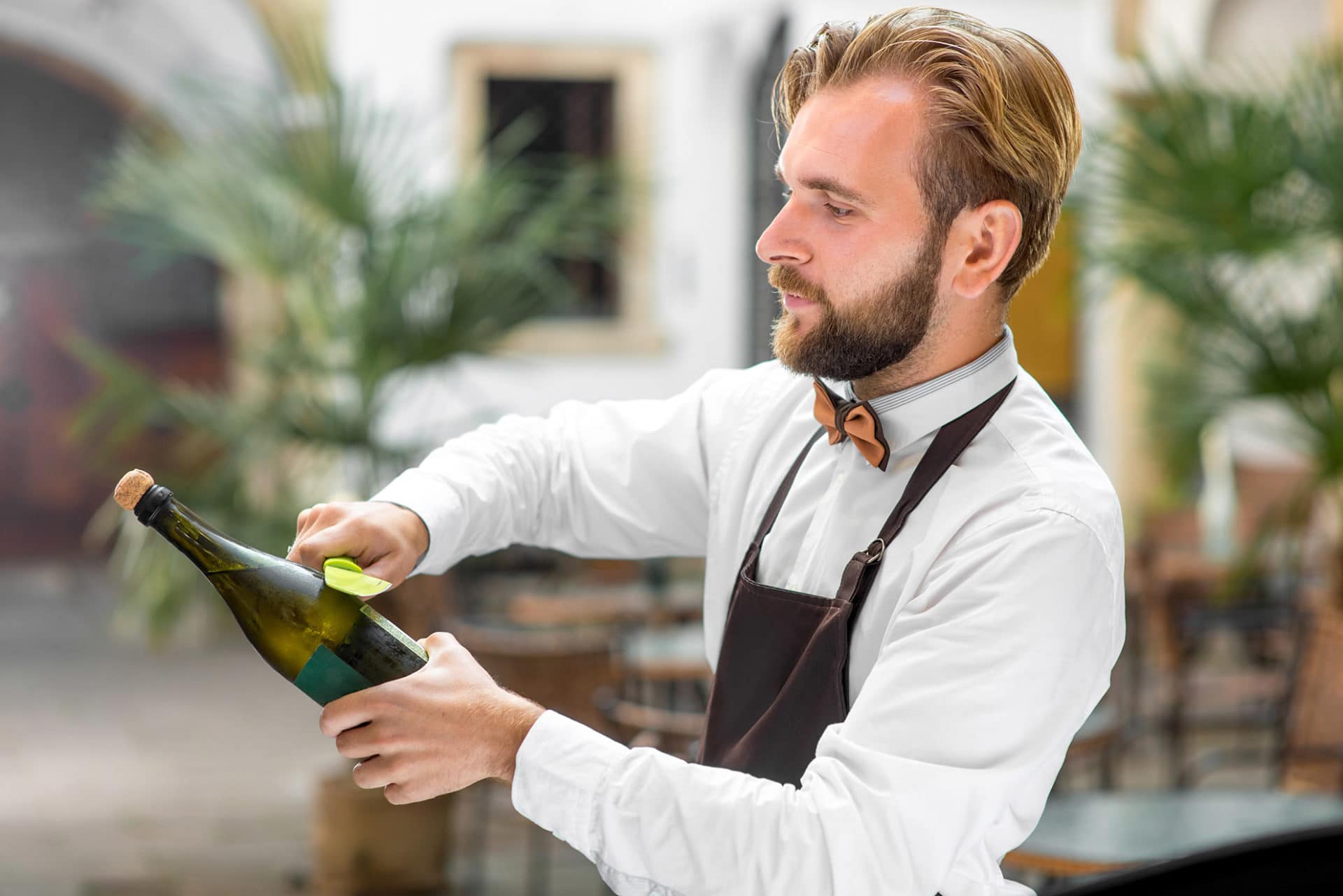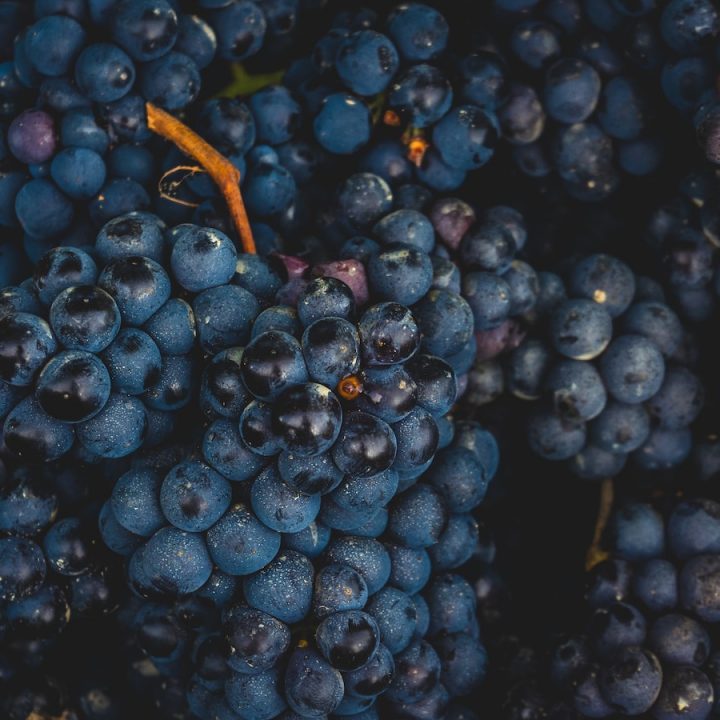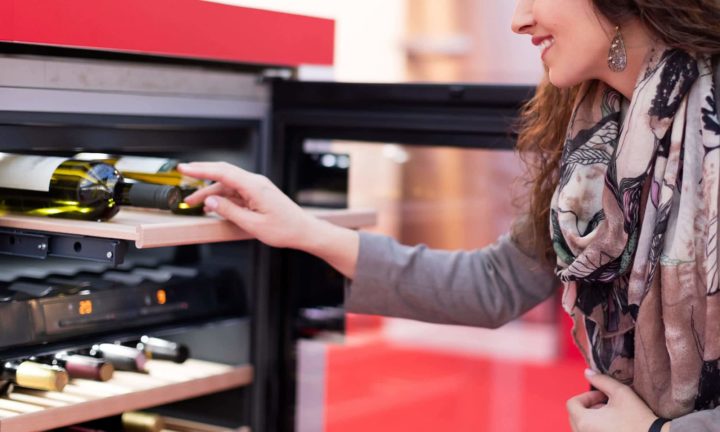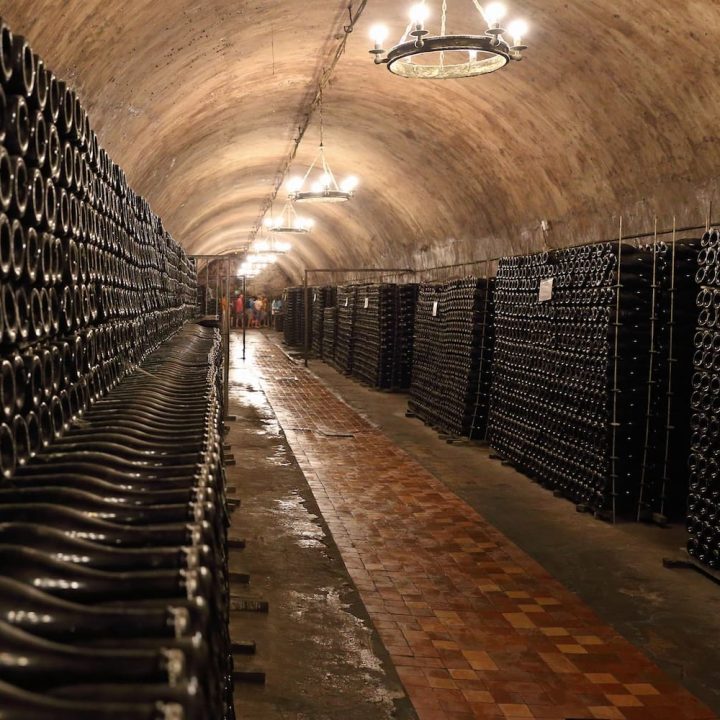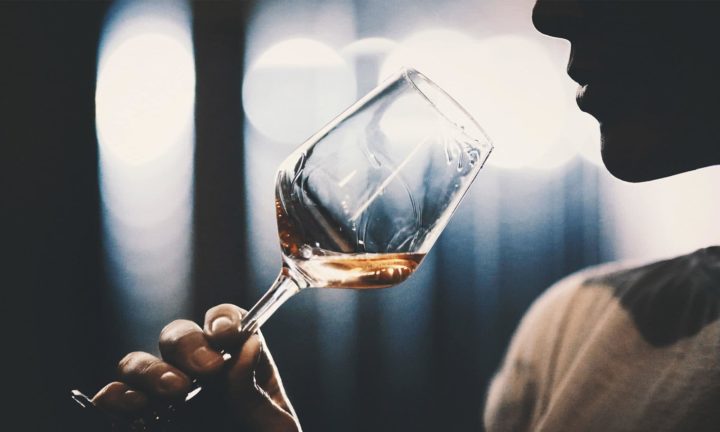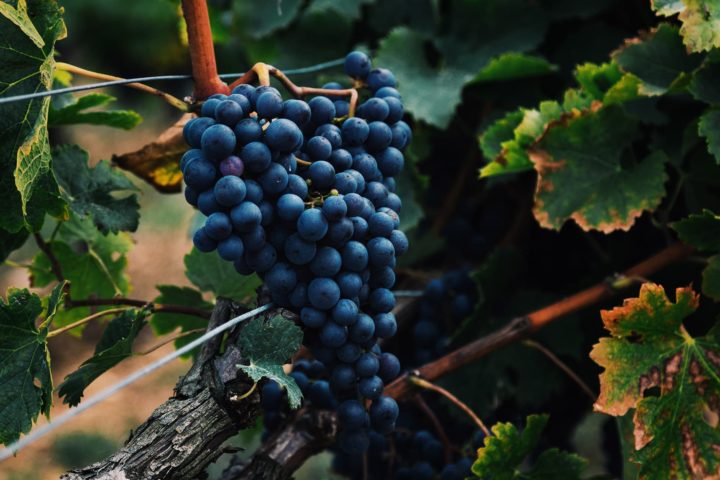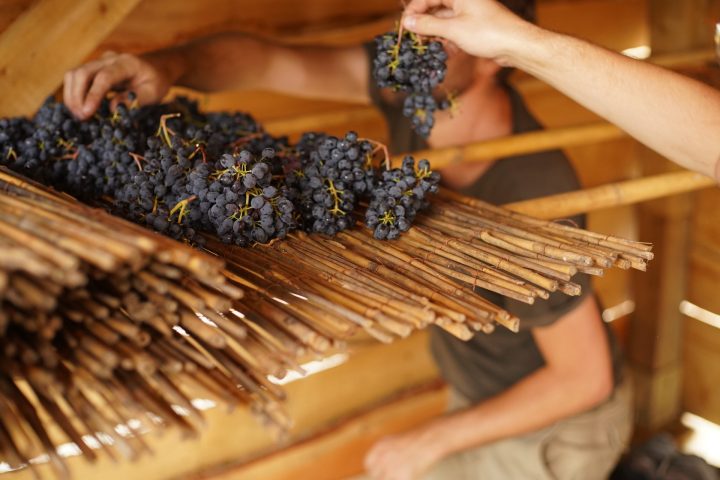Emperor Napoleon I loved champagne. After winning a campaign against the Russian Tsarist Empire in 1812, he and his cavalry officers are said to have decapitated champagne bottles with a sabre (French “sabre”). The art of sabering is still cultivated today. Meanwhile, there are special champagne sabers for this purpose.
Knocking off the neck of the bottle with a champagne saber is not without danger. Due to the high internal pressure of the bottle, the bottle head together with the cork can fly through the air for several meters. Therefore, only those who have mastered the method should open bottles of champagne in this way.
In France, the Confrérie du Sabre d’Or (German “Brotherhood of the Golden Sabre “) has made it its mission to maintain and pass on the tradition of sabering.
This text describes how the sabring works in detail. Where you can experience a Sabrage live and where you can learn Sabrage, you can also find out here.
The sabring process in detail
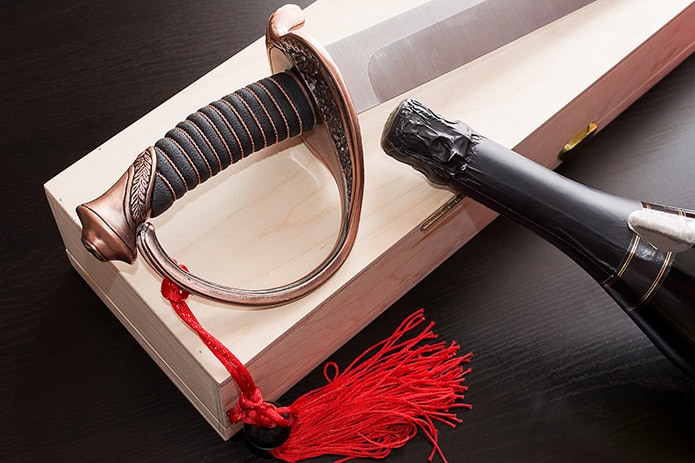
Over time, this sash evolved into a rank insignia for officers. The cutting edge of the sabers is made of stainless steel. It is blunt, because a sharp edge would absorb the force of the saber’s movement and deform. Only a blunt cutting edge can trigger the predetermined breaking point at the junction of the bottle seam and the bead on the bottle neck by the force of the gentle movement.
Champagne saber for a sabrage
Preis inkl. MwSt., ggf. zzgl. Versandkosten / Letzte Aktualisierung am 2025-07-12 / Affiliate Links / Bildquelle: Amazon Product Advertising API
Guidance for buying a champagne saber
If you are thinking about buying a champagne saber for private use, you will find an extensive range of sabers in various designs and price ranges on Amazon, for example. The respective customer reviews are helpful, because they share praise and possibly criticism about the respective champagne saber based on their own experiences. Another guide to buying a saber is provided by test reports on the Internet.
What to consider when sabering in a private setting
Sabering requires careful and practiced handling of the champagne saber. The necessary knowledge for this is best shown to you by a certified sabreur. For practice, you can use champagne bottles before attempting to head a champagne bottle. An absolute no-go is sabering while drunk or intoxicated. The safety of the sabreur and the spectators should be ensured by a sufficient safety distance and a free “trajectory” for the neck of the bottle and the cork. After all, the saber does not always work right away.
In this video you can see the ideal process of a sabrage in the first part. The second part shows that even with professional sabreurs unforeseen things can happen during sabrage.
You are currently viewing a placeholder content from YouTube. To access the actual content, click the button below. Please note that doing so will share data with third-party providers.
More InformationOver time, this sash evolved into a rank insignia for officers. The cutting edge of the sabers is made of stainless steel. It is blunt, because a sharp edge would absorb the force of the saber’s movement and deform. Only a blunt cutting edge can trigger the predetermined breaking point at the junction of the bottle seam and the bead on the bottle neck by the force of the gentle movement.
Champagne saber for a sabrage
Preis inkl. MwSt., ggf. zzgl. Versandkosten / Letzte Aktualisierung am 2025-07-12 / Affiliate Links / Bildquelle: Amazon Product Advertising API
Guidance for buying a champagne saber
If you are thinking about buying a champagne saber for private use, you will find an extensive range of sabers in various designs and price ranges on Amazon, for example. The respective customer reviews are helpful, because they share praise and possibly criticism about the respective champagne saber based on their own experiences. Another guide to buying a saber is provided by test reports on the Internet.
What to consider when sabering in a private setting
Sabering requires careful and practiced handling of the champagne saber. The necessary knowledge for this is best shown to you by a certified sabreur. For practice, you can use champagne bottles before attempting to head a champagne bottle. An absolute no-go is sabering while drunk or intoxicated. The safety of the sabreur and the spectators should be ensured by a sufficient safety distance and a free “trajectory” for the neck of the bottle and the cork. After all, the saber does not always work right away.
In this video you can see the ideal process of a sabrage in the first part. The second part shows that even with professional sabreurs unforeseen things can happen during sabrage.
You are currently viewing a placeholder content from YouTube. To access the actual content, click the button below. Please note that doing so will share data with third-party providers.
More InformationExperience a champagne sabrage in Florence
In Florence you can experience a sabrage live in a five star hotel. At the St. Regis Hotel in Piazza Ognissanti, a sabrage will take place every evening between 7 and 8 p.m. in the exclusive Winter Garden Bar. This arrangement includes a glass of champagne, an oyster and three different finger foods from restaurant chef and Michelin-starred chef Michele Griglio. In this short video, Bar Manager Christian Pampo demonstrates a sabrage with explanations in English.
You are currently viewing a placeholder content from YouTube. To access the actual content, click the button below. Please note that doing so will share data with third-party providers.
More InformationVarious designs of champagne sabers
Champagne sabers are available for professional and personal use. The French brand Laguiole offers both smaller champagne sabers, which resemble a larger knife in shape, and larger luxury versions with round handles. Equally wide-ranging are the offerings for champagne sabers from Italian suppliers Due Cigni in Florence and Fox Knives in Maniago in northern Italy.
The round handles of larger champagne sabers are made of wood or steel. Some sabers have a loop on the handle with a fringe or beaded finish. Today, this ornament is used for decoration. It is reminiscent of the fist strap that was wrapped around the wrist of soldiers in Napoleon’s time to prevent the saber from falling.
Over time, this sash evolved into a rank insignia for officers. The cutting edge of the sabers is made of stainless steel. It is blunt, because a sharp edge would absorb the force of the saber’s movement and deform. Only a blunt cutting edge can trigger the predetermined breaking point at the junction of the bottle seam and the bead on the bottle neck by the force of the gentle movement.
Champagne saber for a sabrage
Preis inkl. MwSt., ggf. zzgl. Versandkosten / Letzte Aktualisierung am 2025-07-12 / Affiliate Links / Bildquelle: Amazon Product Advertising API
Guidance for buying a champagne saber
If you are thinking about buying a champagne saber for private use, you will find an extensive range of sabers in various designs and price ranges on Amazon, for example. The respective customer reviews are helpful, because they share praise and possibly criticism about the respective champagne saber based on their own experiences. Another guide to buying a saber is provided by test reports on the Internet.
What to consider when sabering in a private setting
Sabering requires careful and practiced handling of the champagne saber. The necessary knowledge for this is best shown to you by a certified sabreur. For practice, you can use champagne bottles before attempting to head a champagne bottle. An absolute no-go is sabering while drunk or intoxicated. The safety of the sabreur and the spectators should be ensured by a sufficient safety distance and a free “trajectory” for the neck of the bottle and the cork. After all, the saber does not always work right away.
In this video you can see the ideal process of a sabrage in the first part. The second part shows that even with professional sabreurs unforeseen things can happen during sabrage.
You are currently viewing a placeholder content from YouTube. To access the actual content, click the button below. Please note that doing so will share data with third-party providers.
More InformationHe has already led unusual projects called “Wines and Paintings” or “Champagne and Ice Cream”. The Champagne Sommelier also introduces the art of sabrage. On the island of Sylt, you can take part in a sabering workshop with him and, after receiving instruction, open your first bottle of champagne with a saber – just like Napoleon did more than 200 years ago. Here you can find more information about the course.
Experience a champagne sabrage in Florence
In Florence you can experience a sabrage live in a five star hotel. At the St. Regis Hotel in Piazza Ognissanti, a sabrage will take place every evening between 7 and 8 p.m. in the exclusive Winter Garden Bar. This arrangement includes a glass of champagne, an oyster and three different finger foods from restaurant chef and Michelin-starred chef Michele Griglio. In this short video, Bar Manager Christian Pampo demonstrates a sabrage with explanations in English.
You are currently viewing a placeholder content from YouTube. To access the actual content, click the button below. Please note that doing so will share data with third-party providers.
More InformationVarious designs of champagne sabers
Champagne sabers are available for professional and personal use. The French brand Laguiole offers both smaller champagne sabers, which resemble a larger knife in shape, and larger luxury versions with round handles. Equally wide-ranging are the offerings for champagne sabers from Italian suppliers Due Cigni in Florence and Fox Knives in Maniago in northern Italy.
The round handles of larger champagne sabers are made of wood or steel. Some sabers have a loop on the handle with a fringe or beaded finish. Today, this ornament is used for decoration. It is reminiscent of the fist strap that was wrapped around the wrist of soldiers in Napoleon’s time to prevent the saber from falling.
Over time, this sash evolved into a rank insignia for officers. The cutting edge of the sabers is made of stainless steel. It is blunt, because a sharp edge would absorb the force of the saber’s movement and deform. Only a blunt cutting edge can trigger the predetermined breaking point at the junction of the bottle seam and the bead on the bottle neck by the force of the gentle movement.
Champagne saber for a sabrage
Preis inkl. MwSt., ggf. zzgl. Versandkosten / Letzte Aktualisierung am 2025-07-12 / Affiliate Links / Bildquelle: Amazon Product Advertising API
Guidance for buying a champagne saber
If you are thinking about buying a champagne saber for private use, you will find an extensive range of sabers in various designs and price ranges on Amazon, for example. The respective customer reviews are helpful, because they share praise and possibly criticism about the respective champagne saber based on their own experiences. Another guide to buying a saber is provided by test reports on the Internet.
What to consider when sabering in a private setting
Sabering requires careful and practiced handling of the champagne saber. The necessary knowledge for this is best shown to you by a certified sabreur. For practice, you can use champagne bottles before attempting to head a champagne bottle. An absolute no-go is sabering while drunk or intoxicated. The safety of the sabreur and the spectators should be ensured by a sufficient safety distance and a free “trajectory” for the neck of the bottle and the cork. After all, the saber does not always work right away.
In this video you can see the ideal process of a sabrage in the first part. The second part shows that even with professional sabreurs unforeseen things can happen during sabrage.
You are currently viewing a placeholder content from YouTube. To access the actual content, click the button below. Please note that doing so will share data with third-party providers.
More Information- Rank 1: Sabreur This first rank can be obtained in certified caveaux.
- Rank 2: Chevalier-Sabreur This degree can only be awarded during a Grand Chapitre International or during a Champagne Festival (Chapitre). The rank level enables to teach the sabering.
- Rank 3: Maître-Sabreur This rank is reserved for those in charge of a caveau.
- Rank 4: Officier The requirement for this grade is more than five years of experience as a Chevalier-Sabreur. Again, this rank can only be conferred at a Chapitre or the Grand Chapitre International.
- Rank 5: Commander This appointment requires a minimum of five years as an officer.
- Rank 6: Grand Commander This highest rank can only be achieved by those who have held the rank of Commander for more than five years.
Learn to saber on Sylt
Nils Lackner is a sommelier for champagne and wine. After working as a sommelier all over the world, the famous Sansibar on his home island of Sylt hired him. Lackner founded his own company in Westerland in 2014. He is considered a modern sommelier who puts the fun in the product in the foreground.
He has already led unusual projects called “Wines and Paintings” or “Champagne and Ice Cream”. The Champagne Sommelier also introduces the art of sabrage. On the island of Sylt, you can take part in a sabering workshop with him and, after receiving instruction, open your first bottle of champagne with a saber – just like Napoleon did more than 200 years ago. Here you can find more information about the course.
Experience a champagne sabrage in Florence
In Florence you can experience a sabrage live in a five star hotel. At the St. Regis Hotel in Piazza Ognissanti, a sabrage will take place every evening between 7 and 8 p.m. in the exclusive Winter Garden Bar. This arrangement includes a glass of champagne, an oyster and three different finger foods from restaurant chef and Michelin-starred chef Michele Griglio. In this short video, Bar Manager Christian Pampo demonstrates a sabrage with explanations in English.
You are currently viewing a placeholder content from YouTube. To access the actual content, click the button below. Please note that doing so will share data with third-party providers.
More InformationVarious designs of champagne sabers
Champagne sabers are available for professional and personal use. The French brand Laguiole offers both smaller champagne sabers, which resemble a larger knife in shape, and larger luxury versions with round handles. Equally wide-ranging are the offerings for champagne sabers from Italian suppliers Due Cigni in Florence and Fox Knives in Maniago in northern Italy.
The round handles of larger champagne sabers are made of wood or steel. Some sabers have a loop on the handle with a fringe or beaded finish. Today, this ornament is used for decoration. It is reminiscent of the fist strap that was wrapped around the wrist of soldiers in Napoleon’s time to prevent the saber from falling.
Over time, this sash evolved into a rank insignia for officers. The cutting edge of the sabers is made of stainless steel. It is blunt, because a sharp edge would absorb the force of the saber’s movement and deform. Only a blunt cutting edge can trigger the predetermined breaking point at the junction of the bottle seam and the bead on the bottle neck by the force of the gentle movement.
Champagne saber for a sabrage
Preis inkl. MwSt., ggf. zzgl. Versandkosten / Letzte Aktualisierung am 2025-07-12 / Affiliate Links / Bildquelle: Amazon Product Advertising API
Guidance for buying a champagne saber
If you are thinking about buying a champagne saber for private use, you will find an extensive range of sabers in various designs and price ranges on Amazon, for example. The respective customer reviews are helpful, because they share praise and possibly criticism about the respective champagne saber based on their own experiences. Another guide to buying a saber is provided by test reports on the Internet.
What to consider when sabering in a private setting
Sabering requires careful and practiced handling of the champagne saber. The necessary knowledge for this is best shown to you by a certified sabreur. For practice, you can use champagne bottles before attempting to head a champagne bottle. An absolute no-go is sabering while drunk or intoxicated. The safety of the sabreur and the spectators should be ensured by a sufficient safety distance and a free “trajectory” for the neck of the bottle and the cork. After all, the saber does not always work right away.
In this video you can see the ideal process of a sabrage in the first part. The second part shows that even with professional sabreurs unforeseen things can happen during sabrage.
You are currently viewing a placeholder content from YouTube. To access the actual content, click the button below. Please note that doing so will share data with third-party providers.
More InformationThe Brotherhood of the Confrérie du Sabre D’or
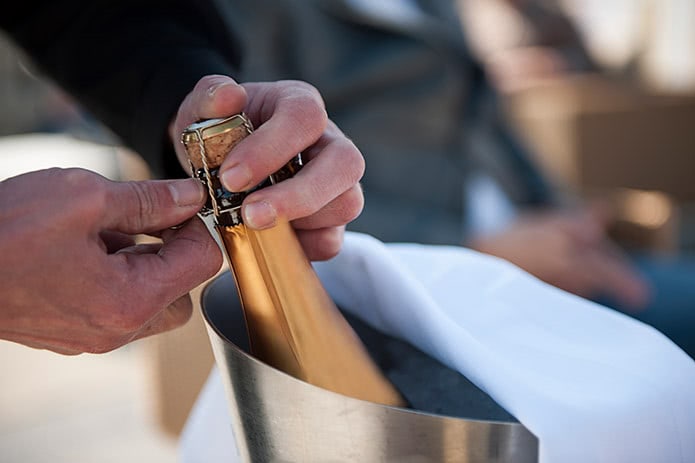
In 1986, the Brotherhood of the Golden Saber was founded in Champagne. The symbol of the organization is the Golden Sabre, the Sabre d’Or. Branches of the association, with about 200,000 members, exist all over the world. In addition to maintaining the tradition of sabering, giving to charity from membership dues is also one of the Brotherhood’s goals.
Once a year there is an international meeting of the Confrérie (Grand Chapitre International). Throughout the year, champagne festivals (chapitres) of the brotherhood are held all over the world. The brotherhood includes selected restaurants, hotels and castles. These are called caveaux (vaulted cellars). In these caveaux, sabering is demonstrated and taught by experienced sabreurs. On the Confrérie website you will find lists of caveaux in France sorted by country.
In Germany, the restaurant at the four-star Bellevue Spa & Resort Reiterhof Wirsberg hotel (near Bayreuth) and the French restaurant Giverny in Münster are among the caveaux. Here you can experience a sabrage.
The ranks of the Sabre of the Confrérie du Sabre d’Or
The following six ranks are awarded by the Confrérie du Sabre d’Or for mastery of sabering:
- Rank 1: Sabreur This first rank can be obtained in certified caveaux.
- Rank 2: Chevalier-Sabreur This degree can only be awarded during a Grand Chapitre International or during a Champagne Festival (Chapitre). The rank level enables to teach the sabering.
- Rank 3: Maître-Sabreur This rank is reserved for those in charge of a caveau.
- Rank 4: Officier The requirement for this grade is more than five years of experience as a Chevalier-Sabreur. Again, this rank can only be conferred at a Chapitre or the Grand Chapitre International.
- Rank 5: Commander This appointment requires a minimum of five years as an officer.
- Rank 6: Grand Commander This highest rank can only be achieved by those who have held the rank of Commander for more than five years.
Learn to saber on Sylt
Nils Lackner is a sommelier for champagne and wine. After working as a sommelier all over the world, the famous Sansibar on his home island of Sylt hired him. Lackner founded his own company in Westerland in 2014. He is considered a modern sommelier who puts the fun in the product in the foreground.
He has already led unusual projects called “Wines and Paintings” or “Champagne and Ice Cream”. The Champagne Sommelier also introduces the art of sabrage. On the island of Sylt, you can take part in a sabering workshop with him and, after receiving instruction, open your first bottle of champagne with a saber – just like Napoleon did more than 200 years ago. Here you can find more information about the course.
Experience a champagne sabrage in Florence
In Florence you can experience a sabrage live in a five star hotel. At the St. Regis Hotel in Piazza Ognissanti, a sabrage will take place every evening between 7 and 8 p.m. in the exclusive Winter Garden Bar. This arrangement includes a glass of champagne, an oyster and three different finger foods from restaurant chef and Michelin-starred chef Michele Griglio. In this short video, Bar Manager Christian Pampo demonstrates a sabrage with explanations in English.
You are currently viewing a placeholder content from YouTube. To access the actual content, click the button below. Please note that doing so will share data with third-party providers.
More InformationVarious designs of champagne sabers
Champagne sabers are available for professional and personal use. The French brand Laguiole offers both smaller champagne sabers, which resemble a larger knife in shape, and larger luxury versions with round handles. Equally wide-ranging are the offerings for champagne sabers from Italian suppliers Due Cigni in Florence and Fox Knives in Maniago in northern Italy.
The round handles of larger champagne sabers are made of wood or steel. Some sabers have a loop on the handle with a fringe or beaded finish. Today, this ornament is used for decoration. It is reminiscent of the fist strap that was wrapped around the wrist of soldiers in Napoleon’s time to prevent the saber from falling.
Over time, this sash evolved into a rank insignia for officers. The cutting edge of the sabers is made of stainless steel. It is blunt, because a sharp edge would absorb the force of the saber’s movement and deform. Only a blunt cutting edge can trigger the predetermined breaking point at the junction of the bottle seam and the bead on the bottle neck by the force of the gentle movement.
Champagne saber for a sabrage
Preis inkl. MwSt., ggf. zzgl. Versandkosten / Letzte Aktualisierung am 2025-07-12 / Affiliate Links / Bildquelle: Amazon Product Advertising API
Guidance for buying a champagne saber
If you are thinking about buying a champagne saber for private use, you will find an extensive range of sabers in various designs and price ranges on Amazon, for example. The respective customer reviews are helpful, because they share praise and possibly criticism about the respective champagne saber based on their own experiences. Another guide to buying a saber is provided by test reports on the Internet.
What to consider when sabering in a private setting
Sabering requires careful and practiced handling of the champagne saber. The necessary knowledge for this is best shown to you by a certified sabreur. For practice, you can use champagne bottles before attempting to head a champagne bottle. An absolute no-go is sabering while drunk or intoxicated. The safety of the sabreur and the spectators should be ensured by a sufficient safety distance and a free “trajectory” for the neck of the bottle and the cork. After all, the saber does not always work right away.
In this video you can see the ideal process of a sabrage in the first part. The second part shows that even with professional sabreurs unforeseen things can happen during sabrage.
You are currently viewing a placeholder content from YouTube. To access the actual content, click the button below. Please note that doing so will share data with third-party providers.
More InformationThe champagne bottle should be cooled before being staved, because the cooler the champagne is, the less it foams. As a result, the champagne gush is less voluminous when the bottle is headed. The champagne can be poured into glasses in a more targeted manner.
- First, carefully remove the aluminum foil and agraffe (wire basket) from the neck of the bottle to expose the glass bottle.
- Right-handed people take the champagne bottle by its lower end in the left hand.
- It is important that the longitudinal seam of the bottle is on top. This is because in order for the neck of the bottle to be knocked off, a kind of predetermined breaking point must be hit with the champagne saber. This is located at the point where the longitudinal seam of the bottle meets the bead on the bottle neck. This is the point where the glass is weakest.
- With the left hand and an almost outstretched arm, the bottle head is then tilted slightly upwards.
- The bottle should point away from the sabreur. It should also not be directed at spectators. Spectators of the ceremony should not be in the immediate vicinity of the action for safety reasons, so that they can not be hit by the cut off neck of the bottle.
- The champagne saber is placed with the other hand on its cutting side flat on the bottle thus aligned.
- With a smooth and flowing motion, the saber is then directed forward with little effort and pushed against the bead on the neck of the bottle. Ideally, the great pressure with which the champagne is catapulted from the bottle creates a clean break.
- The champagne can now be poured directly into glasses.
However, shards in the glass are rare. To be on the safe side, it is nevertheless advisable to visually inspect the champagne in the glass. Any glass splinters contained jump directly into the eye due to their green color.
The chipped neck of the bottle with the cork is often inscribed with the date of the sabrage in France and kept as a good luck charm.
The Brotherhood of the Confrérie du Sabre D’or

In 1986, the Brotherhood of the Golden Saber was founded in Champagne. The symbol of the organization is the Golden Sabre, the Sabre d’Or. Branches of the association, with about 200,000 members, exist all over the world. In addition to maintaining the tradition of sabering, giving to charity from membership dues is also one of the Brotherhood’s goals.
Once a year there is an international meeting of the Confrérie (Grand Chapitre International). Throughout the year, champagne festivals (chapitres) of the brotherhood are held all over the world. The brotherhood includes selected restaurants, hotels and castles. These are called caveaux (vaulted cellars). In these caveaux, sabering is demonstrated and taught by experienced sabreurs. On the Confrérie website you will find lists of caveaux in France sorted by country.
In Germany, the restaurant at the four-star Bellevue Spa & Resort Reiterhof Wirsberg hotel (near Bayreuth) and the French restaurant Giverny in Münster are among the caveaux. Here you can experience a sabrage.
The ranks of the Sabre of the Confrérie du Sabre d’Or
The following six ranks are awarded by the Confrérie du Sabre d’Or for mastery of sabering:
- Rank 1: Sabreur This first rank can be obtained in certified caveaux.
- Rank 2: Chevalier-Sabreur This degree can only be awarded during a Grand Chapitre International or during a Champagne Festival (Chapitre). The rank level enables to teach the sabering.
- Rank 3: Maître-Sabreur This rank is reserved for those in charge of a caveau.
- Rank 4: Officier The requirement for this grade is more than five years of experience as a Chevalier-Sabreur. Again, this rank can only be conferred at a Chapitre or the Grand Chapitre International.
- Rank 5: Commander This appointment requires a minimum of five years as an officer.
- Rank 6: Grand Commander This highest rank can only be achieved by those who have held the rank of Commander for more than five years.
Learn to saber on Sylt
Nils Lackner is a sommelier for champagne and wine. After working as a sommelier all over the world, the famous Sansibar on his home island of Sylt hired him. Lackner founded his own company in Westerland in 2014. He is considered a modern sommelier who puts the fun in the product in the foreground.
He has already led unusual projects called “Wines and Paintings” or “Champagne and Ice Cream”. The Champagne Sommelier also introduces the art of sabrage. On the island of Sylt, you can take part in a sabering workshop with him and, after receiving instruction, open your first bottle of champagne with a saber – just like Napoleon did more than 200 years ago. Here you can find more information about the course.
Experience a champagne sabrage in Florence
In Florence you can experience a sabrage live in a five star hotel. At the St. Regis Hotel in Piazza Ognissanti, a sabrage will take place every evening between 7 and 8 p.m. in the exclusive Winter Garden Bar. This arrangement includes a glass of champagne, an oyster and three different finger foods from restaurant chef and Michelin-starred chef Michele Griglio. In this short video, Bar Manager Christian Pampo demonstrates a sabrage with explanations in English.
You are currently viewing a placeholder content from YouTube. To access the actual content, click the button below. Please note that doing so will share data with third-party providers.
More InformationVarious designs of champagne sabers
Champagne sabers are available for professional and personal use. The French brand Laguiole offers both smaller champagne sabers, which resemble a larger knife in shape, and larger luxury versions with round handles. Equally wide-ranging are the offerings for champagne sabers from Italian suppliers Due Cigni in Florence and Fox Knives in Maniago in northern Italy.
The round handles of larger champagne sabers are made of wood or steel. Some sabers have a loop on the handle with a fringe or beaded finish. Today, this ornament is used for decoration. It is reminiscent of the fist strap that was wrapped around the wrist of soldiers in Napoleon’s time to prevent the saber from falling.
Over time, this sash evolved into a rank insignia for officers. The cutting edge of the sabers is made of stainless steel. It is blunt, because a sharp edge would absorb the force of the saber’s movement and deform. Only a blunt cutting edge can trigger the predetermined breaking point at the junction of the bottle seam and the bead on the bottle neck by the force of the gentle movement.
Champagne saber for a sabrage
Preis inkl. MwSt., ggf. zzgl. Versandkosten / Letzte Aktualisierung am 2025-07-12 / Affiliate Links / Bildquelle: Amazon Product Advertising API
Guidance for buying a champagne saber
If you are thinking about buying a champagne saber for private use, you will find an extensive range of sabers in various designs and price ranges on Amazon, for example. The respective customer reviews are helpful, because they share praise and possibly criticism about the respective champagne saber based on their own experiences. Another guide to buying a saber is provided by test reports on the Internet.
What to consider when sabering in a private setting
Sabering requires careful and practiced handling of the champagne saber. The necessary knowledge for this is best shown to you by a certified sabreur. For practice, you can use champagne bottles before attempting to head a champagne bottle. An absolute no-go is sabering while drunk or intoxicated. The safety of the sabreur and the spectators should be ensured by a sufficient safety distance and a free “trajectory” for the neck of the bottle and the cork. After all, the saber does not always work right away.
In this video you can see the ideal process of a sabrage in the first part. The second part shows that even with professional sabreurs unforeseen things can happen during sabrage.
You are currently viewing a placeholder content from YouTube. To access the actual content, click the button below. Please note that doing so will share data with third-party providers.
More Information